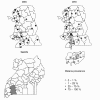Heterogeneous decrease in malaria prevalence in children over a six-year period in south-western Uganda
- PMID: 21592332
- PMCID: PMC3120731
- DOI: 10.1186/1475-2875-10-132
Heterogeneous decrease in malaria prevalence in children over a six-year period in south-western Uganda
Abstract
Background: Malaria is a major public health problem, especially for children. However, recent reports suggest a decline in the malaria burden. The aim of this study was to assess the change in the prevalence of malaria infection among children below five years of age between 2004 and 2010 in a mesoendemic area of Uganda and to analyse the risk factors of malaria infection.
Methods: Two cross-sectional surveys were conducted in 2004 and in 2010 at the end of the rainy and dry seasons to measure the prevalence of P. falciparum infection among children less than five years of age. Rapid diagnostic tests and blood smears were used to diagnose malaria infection. In 2010, sampling was stratified by urban and rural areas. In each selected household, knowledge of malaria and bed nets, and bed net ownership and use, were assessed.
Results: In 2004 and 2010, respectively, a total of 527 and 2,320 (999 in the urban area and 1,321 in rural areas) children less than five years old were enrolled. Prevalence of malaria infection declined from 43% (95% CI: 34-52) in 2004, to 23% (95% CI: 17-30) in rural areas in 2010 and 3% (95% CI: 2-5) in the urban area in 2010. From the rainy to dry season in 2010, prevalence decreased from 23% to 10% (95% CI: 6-14) in rural areas (P = 0.001) and remained stable from 3% to 4% (95% CI: 1-7) in the urban area (P = 0.9). The proportion of households reporting ownership and use of at least one bed net increased from 22.9% in 2004 to 64.7% in the urban area and 44.5% in rural areas in 2010 (P < 0.001). In 2010, the risk of malaria infection was consistently associated with child age and household wealth. In rural areas, malaria infection was also associated with geographic factors.
Conclusions: This study reports a significant drop in the prevalence of malaria infection among children below five years of age, paralleled by an uptake in bed-net use. However, prevalence remains unacceptably high in rural areas and is strongly associated with poverty.
Figures


References
-
- World Health Organisation. World malaria report 2008. Geneva: WHO; 2008.
-
- World Health Organisation. World malaria report 2009. Geneva: WHO; 2009.
-
- Otten M, Aregawi M, Were W, Karema C, Medin A, Bekele W, Jima D, Gausi K, Komatsu R, Korenromp E. et al.Initial evidence of reduction of malaria cases and deaths in Rwanda and Ethiopia due to rapid scale-up of malaria prevention and treatment. Malar J. 2009;8:14. doi: 10.1186/1475-2875-8-14. - DOI - PMC - PubMed
-
- Nyarango PM, Gebremeskel T, Mebrahtu G, Mufunda J, Abdulmumini U, Ogbamariam A, Kosia A, Gebremichael A, Gunawardena D, Ghebrat Y. et al.A steep decline of malaria morbidity and mortality trends in Eritrea between 2000 and 2004: the effect of combination of control methods. Malar J. 2006;5:33. doi: 10.1186/1475-2875-5-33. - DOI - PMC - PubMed
Publication types
MeSH terms
LinkOut - more resources
Full Text Sources
Medical

